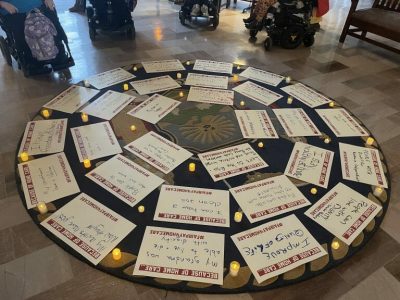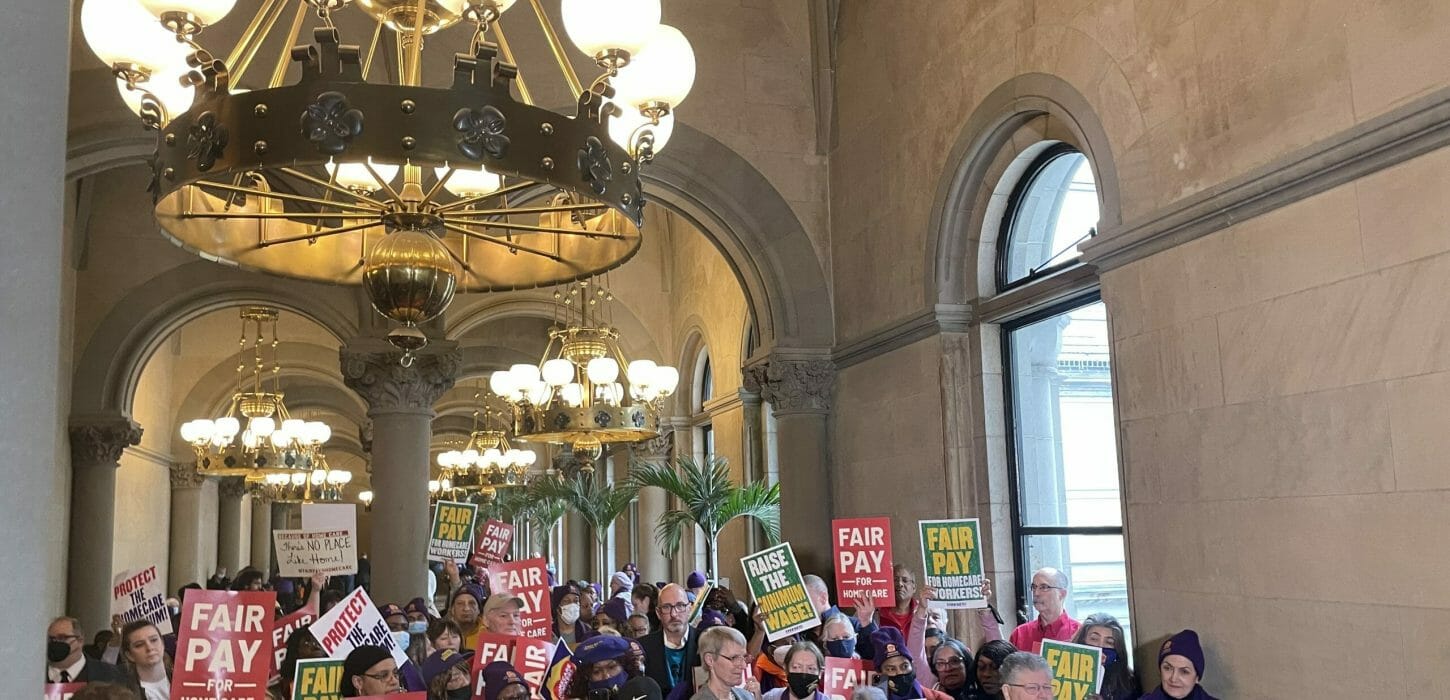A familiar crowd gathered in New York’s Capitol last week. The purple and gold beanies of 1199SEIU, the turquoise tees of the Consumer Directed Personal Assistance Association, and the custom red face masks of the Caring Majority campaign made for a cacophony of color and conviction.
People showed up in full gear for good reason: to fight, again, for fair pay for home care.
Last year, this movement succeeded in securing a home care worker wage increase in the statewide budget. Governor Kathy Hochul allocated $7.7 billion to phase in $3-an-hour raises over two years.
In a state with the nation’s worst home care shortage and a rapidly aging population, a pay bump couldn’t come soon enough.
In 2020, per the Paraprofessional Healthcare Institute’s Workforce Data Center, 58 percent of home care workers received public assistance. Workers in New York City now make a minimum of $17 an hour, while those outside the city now take home at least $15.20, two dollars more than at the start of 2022.
But less than a year later, the newly elected governor wants to turn back the clock. Her proposed 2024 budget tethers home care workers’ wages to the eventual minimum wage — when it reaches 18 dollars, hourly pay will freeze, and workers will again be earning at the very bottom, rapidly outpaced by the cost of living.
In the words of Caring Majority’s co-director, Ilana Berger, skimping on wages is akin to “throwing gasoline” on the fire that is New York’s care crisis.
Instead of the governor’s plan, home care workers and clients alike prefer the Fair Pay for Home Care Act, which would index home care workers’ minimum wage to 150 percent of the state’s minimum wage, facilitate provider reimbursement under Medicaid, and ensure that money reaches workers instead of finding harbor in private insurance companies.

1199SEIU member and home care worker Sylvia Brockerton speaks at the rally.
“I could make more money working at Amazon or Walmart,” said Sylvia Brockerton — a New York City home care worker and 1199SEIU member — at Monday’s rally. “But I choose to be a home care worker, because I feel that I am making my clients’ lives better, giving them the dignity to stay in their own home and be a part of the community.”
Noting she hadn’t taken a day off over two years, Brockerton put the problem simply: “We are not given the respect and dignity that we give our clients.”
“My biggest fear is being put out on the street,” says 1199 #homecare worker Kim Thompson-Werekoh. She’s with her #union family in Albany today to call on @GovKathyHochul & NY legislators to improve jobs of NY’s dedicated homecare workers who are living on the brink. #Budget2023 pic.twitter.com/79JbARgN7K
— 1199SEIU💫 (@1199SEIU) February 6, 2023
As is common across American professions, the “labor shortage” myth obscures why there really aren’t enough home care workers: low pay forces them out of the profession.
The Consumer Directed Personal Assistance Association of New York State’s 2021 report revealed that over half of the state’s departing care workforce left due to inadequate wages. A broader, allied movement making waves in Albany this budget season, Raise Up NY, hopes to increase the minimum wage to $20 across all industries — and secure its growth alongside inflation.
Workers aren’t the only group out battling for fair pay. Clients of home care — including a large contingent of disability justice advocates — showed out in equal measure.

Sage Jobsis advocates in Albany
“I had never paid any attention to what a struggle it was for people who needed assistance,” said Sage Jobsis, a Caring Majority advocate from the Hudson Valley who’s rallied for fair pay for several years. “I ended up where I needed it and realized how impossible it is to find care.”
After receiving a multiple sclerosis diagnosis at age 30, Jobsis and her family had difficult conversations about her quality of life: whether it would be easier to enter a nursing home or stay home. “I put my foot down, saying, ‘I’m 35, I don’t need to be in a nursing home.’ So we had to scramble to find home care aides.”
But that process felt nearly impossible, considering the out-of-pocket expense for consumer directed care — to which Jobsis, who is on Medicaid and Medicare, turned after agencies came up short on staff.
“I’ve basically sweet talked my friends and family into working with me, and asked them to sacrifice a bunch of money to work with me so I can get out of bed every day and take a shower. As I’ve been losing my vision and ability to walk, instead of just emotionally supporting me, they’re helping me with things like making myself eggs in the morning.”
“You are often not listened to when you have a disability — people treat me like a child or address me like a kid who stubbed their toe or something.” But when Jobsis found the Caring Majority campaign, she felt recognition. “Not only were people willing to listen to me, but they were fighting with me for something that I needed.”
A 2021 CUNY study concluded that Fair Pay for Home Care wouldn’t just be an up-front “cost” in terms of wages. A raise would net New York at least $3.7 billion in annual revenue from economic benefits — such as spillover, turnover reduction, new tax revenue, and productivity gains — and draw tens of thousands of new home care workers into the state’s ranks each year.
“You can follow the money and see who the state cares about,” said Jobsis. “It doesn’t really care about people with disabilities, the elderly, or home care workers, who are in general women and women of color.”
That isn’t to say that legislators aren’t on board. Both the Senate and Assembly approved of the Fair Pay for Home Care Act during last year’s budget negotiations. Helmed by Senator Rachel May (D-48), the bill enjoys support from handfuls of lawmakers across the political spectrum — including, importantly, the Assembly’s new Health Committee chair, Amy Paulin (D-88).
“I am watching that there isn’t funny language in the plans that exempts us from a minimum wage increase,” Paulin pledged on Monday. Several politicians followed suit, vowing to codify living wages.

Caring Majority members place “Because of home care” signs in the New York Capitol.
After the rally, advocates fanned out throughout the Capitol to meet with their elected officials. Some members of the Caring Majority, including Jobsis, made their way to the building’s War Room, arranging candles and handwritten “Because of home care…” signs in its center.
Because of home care, my friend and I can go out like normal 30 year olds. My grandma was able to live and die with dignity. My daughter graduated from college. “Because of home care, I can have a clean ass,” someone read out.
“That is so real!” Others laughed.
They added one more sign: Because of home care, anything is possible.
And then the Caring Majority sang their song.
A Caring Majority Choir clip to brighten your day❤️
Singing for Our Lives:
We are gentle angry people
We are justice-seeking people
We are young & old together
We are caregivers & fighters
We are older & disabled
We are care workers & daughtersAnd we need #FairPay4HomeCare pic.twitter.com/KxMuyu6wEz
— NY Caring Majority 🍎 (@CaringMajority) April 2, 2022
